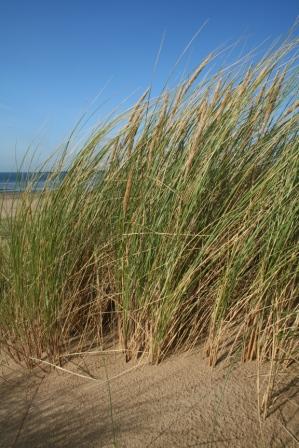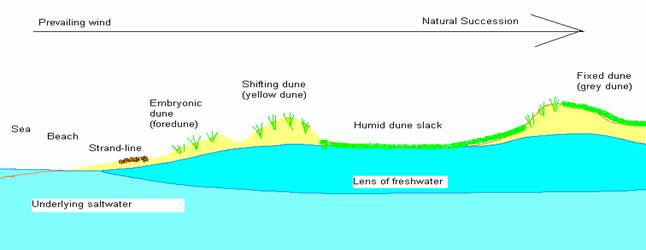Anglesey contains some of the finest examples of coastal dune
ecosystems in the UK - indeed some are recognised as of international
significance.
The hard rock outcrops of the west coast, reflecting the rippling
geological strata of the island and the erosion of the softer rocks
into bays, provide the anchorage for a series of dune systems. From
small areas at Traeth Mawr near Llanfachraeth in the north and at
Borth Wen, Rhoscolyn, dunes extend down the coast of Caernarfon bay,
via the large, relict system at Tywyn Trewan (now mostly under a
military airfield) and at Rhosneigr, to the spectacular dune fields
of Tywyn Aberffraw
and Newborough Warren.
Ecology of Sand Dunes Sand dunes can develop wherever there is a supply
of dry sand grains mobilised by the wind. In coastal locations they
depend on a sufficiently wide beach at low tide, allowing dry sand to
be picked up and blown inland. A dune grows as sand grains come to rest
around obstacles on the beach such as seaweed or driftwood, behind dune
ridges or around foreshore plants such as sea rocket
Cakile maritima or lyme grass Leymus arenarius.
The most important of these is Marram grassAmmophila arenaria,
which is the main sand-binding and dune building species.
Marram grass:
Ammophila arenaria Marram grass Ammophila arenaria is the primary dune building species in Europe.
It colonises dunes and accumulates wind blown sand which is dropped as wind speed is
reduced by obstacles. This coarse grass has an in-rolled leaf, which helps to protect it
from desiccation in the dry dune environment. Its ability to grow up through accumulating
sand, rooting at the leaf nodes, enables it to keep pace with dune growth.
It can be planted to repair and re-vegetate eroding dunes.
Marram grass formed the basis of a mat and rope making cottage industry for many
centuries at Newborough. Dunes on an accreting shoreline may develop a series of dry ridges
with intervening damp valleys or slacks.
Dune ridges may also undergo periodic breakdown at erosion points
leading to "blowouts" with renewed erosion of the dry sand creating
a moving parabolic (curved) dune which migrates gradually inland – see
aerial photo. This process
also creates slacks, through the wind erosion
of dry sand down to the water table.
Blow-out
This is a term used to describe the type of erosion which can occur in the body of the dune
system. A breach in the vegetation cover can enable wind erosion to occur. The dry sand
blows away until erosion reaches the wet sand close to the water table. At this point
dune slacks may develop. The sand is redeposited – often around marram grass, in a growing new
dune. These dunes typically have different shapes depending on the wind speed and
direction.
A pattern of such blowouts can be seen on the
aerial photograph of Newborough dunes.
A dune "slack" is the valley between the sand ridges. It is formed either
by the erosion of dry sand down to the wet sand at the water table, as commonly happened
at Newborough, or by the enclosure of low marsh (e.g. saltmarsh) by a succession of sand
spits.
A very different vegetation, from that of dry dunes, develops in slacks, where the
sand is within reach of the dune system's freshwater table. Under these conditions dune
slacks develop, which are often characterised by a marked annual fluctuation in water level.
Water levels in slacks normally reach a peak in early spring, when many are flooded for
periods of several months. They then fall sharply through the summer, reaching 2 m or more
below ground level before starting to rise again in autumn Ranwell 19
Over time other plants establish as the dune soil develops and later
successional stages include dune grassland, heathland, scrub and
woodland (though this latter stage is very rare in Britain). Slacks
develop a distinctive wetland flora and fauna and it is this intimate
juxtaposition of wet and dry habitat that makes sand dunes such rich
areas for wildlife. The level and quality of the water table is clearly
crucial to the development and maintenance of dune slacks.
The calcium content of the sand is important in determining the
nature of the vegetation and associated fauna. Newborough's sand is
particularly rich in shell content and produces characteristic
calcareous vegetation. On the older parts of the system,leaching (washing out) of the
calcium from the surface layers of the soil can result in the
development of acid dune heath. Wind erosion can return this
calcium-rich sand to the surface.
As a dune forms, plant succession occurs. The conditions on an embryo dune are
harsh, with salt spray from the sea carried on strong winds. The dune is well drained and
often dry. Rotting seaweed brought in by storm waves adds enough nutrients to allow pioneer
species to colonise the dune. These pioneer species are typically sandwort, lyme grass
and marram grass. These plants are well adapted to the harsh conditions of the fore dune,
typically having deep roots which reach the water table, root nodules that produce
nitrogen compounds, and protected stoma (leaf pores), reducing transpiration.
The deep roots also bind the sand together, and the dune grows into a fore dune as more
sand is blown onto the grasses. The grasses shelter, stabilise and add humus to the soil,
meaning other, less hardy plants can then colonise the dunes. Typically these are grasses
such as red fescue or herbs such as cat's ear. These too are adapted to the low soil water
content and have leaf adaptations which reduce transpiration. These plants gradually add
humus to the soil, increasing its water-holding capacity. Young dunes are sometimes called "yellow dunes",
dunes which have high humus content are called "grey dunes". Leaching occurs on the dunes,
washing humus into the slacks, and the slacks may be much more developed than the exposed
tops of the dunes. Leaching also removed lime from the upper horizons of the soil leading
to gradual acidification and reflected in a consequential change in the flora and fauna of
these areas. Eventually, this may enable heather to grow and lead to the establishment of
dune heath – a rare habitat in Wales. Wind erosion can remobilise the lime from lower
levels and return it to the upper soil horizon.
As the dune soil develops, opportunities may arise
for scrub such as hawthorn, willow or birch to grow and eventually for the development of
native dune woodland. This is now a rare habitat in Wales, having generally been reclaimed
for agriculture, golf courses or other development. In contrast, the planting of conifer
plantations on dunes has been extensive. Once the conifer canopy closes, the native ground
flora is largely shaded out and in many areas only a thick carpet of acidic pine needles is
apparent.
Succession is a process in time, but since the coastal dunes are younger than those
inland a walk from the coast back through the dunes is a surrogate for time. This
illustration of succession is an important scientific feature of dunes, extensively used
in teaching and research. Dunes are naturally dynamic, undergoing
periods of erosion and accretion, constantly changing in response to
weather and climate, natural
succession and management.
There is good evidence for the existence of extensive
dunes at Newborough far beyond the earliest written records of 1331,
and for dramatic changes in their stability. The 1951 aerial photograph
1951 shows the nature of the landscape just
55 years ago. This natural dynamism and the ability of such
systems to respond to natural change is the key to their conservation.
The functions and processes of dune ecosystems are the key to
conserving the features that we value.
Dynamics
The constantly changing shape and nature of coastal dunes presents a challenge to understanding and
managing these lands.
Dune landforms are created by the erosion of sand from one area
(a beach or an earlier dune) and its accumulation around an obstacle such as driftwood
or marram grass. Their growth and gradual movement are
natural phenomena. An
aerial view of Newborough dunes reveals at least 4 lines of dunes representing phases
of coastal dune establishment and subsequent migration across the landscape.
Historically, unstable dunes have been seen as a threat to human activities or assets.
Overwhelming agricultural land, farms and other infrastructure by blowing sand and the
threat of flooding have resulted in measures being adopted to stabilise and 'protect' them.
'Engineering' dunes to prevent sand movement and create structures which defend
the land from the sea has often been the principle
management objective, especially on coasts where shoreline erosion is evident. Even in
dune areas identified for their conservation significance 'protecting' the dune from
erosion has often been a major preoccupation, especially where recreational activity is
seen as a key factor in creating erosion. Looking at the sand dune from an ecological
perspective and learning lessons from the way in which sandy beaches and sand dunes
respond to natural perturbations in the environment (climate change, sea level rise and
perhaps most importantly storms) suggest that they made be more resilient than past
protective measures suggest. It is therefore important to understand dune dynamics
and its role in creating high quality and diverse habitat. In prehistoric times the dunes were probably thinly wooded, along
with adjacent areas of the early "
wildwood". Large herbivores such as elk, auroch (cattle) and deer
would have maintained this open woodland structure and many grassy
clearings while fire and erosion episodes would also have contributed to the
diversity of the landscape.
Sand dunes have been managed as far back as Neolithic times.
Historically the most common use of dunes has been the grazing
of domestic stock (though after the clearance of Llanfaes by Edward I and the sudden increase in
Newborough's population it is likely that cultivation was attempted).
Later, rabbits were introduced alongside other domestic stock, creating
distinctive species-rich "lawns" and ensuring a supply of bare sand areas
which are essential for many species of invertebrates, lizards and snakes.
Grazing has helped to create a rich native flora and fauna. The loss
of rabbit grazing at Newborough after myxomatosis in 1956 (and the
absence of other large grazing animals) led to thick rank grassland
and a decline in the species richness of the dunes. The reintroduction
of livestock grazing to the Newborough dunes since 1986 has reversed that trend,
resulting in a trebling of the botanical species-richness of the sward.
In contrast, where domestic stock grazing was maintained (by common
rights) until recently on the adjacent Tywyn Aberffraw dunes, rabbits were able to
maintain a small but significant population and sustained a rich
vascular plant and bryophyte (moss & liverwort) flora and invertebrate fauna.
That site also attracts significant numbers of winter feeding chough
to these short dune grasslands.
A useful reference to dune ecology can be foundhere.
The UK Coastal dunes habitat action plan details the requirements needded to address the UK's international obligations for sand dunes under the Rio Convention.
Many of these actions require the implementation of habitat management or restoration described in the Sand dune restoration guide.


Slack
Succession on coastal dunes